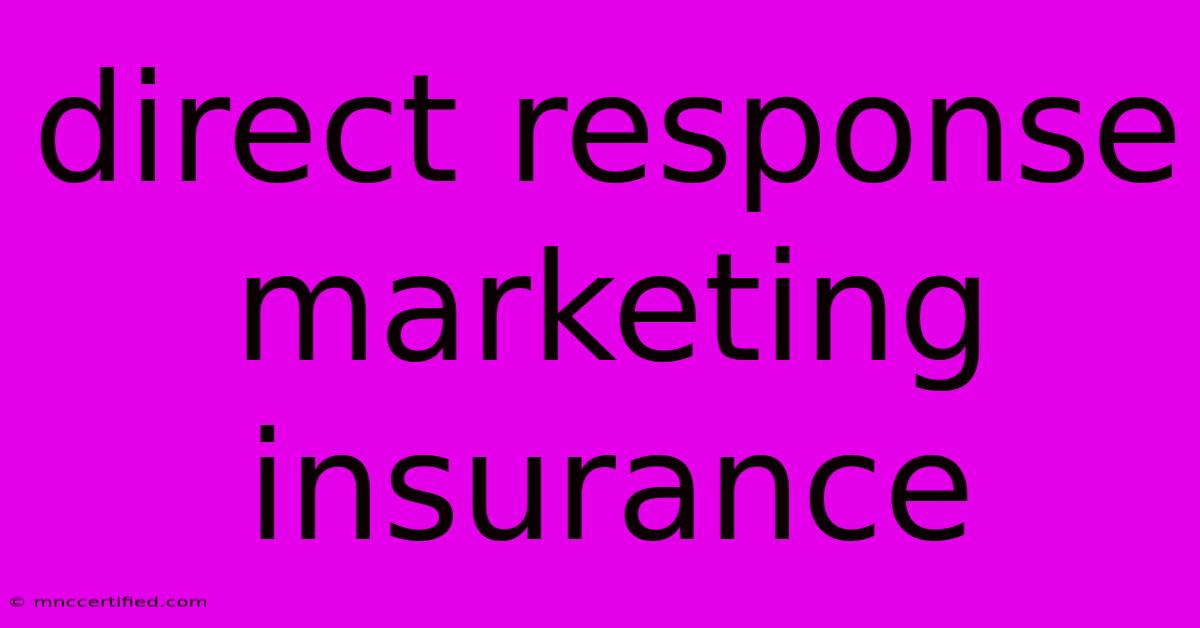Direct Response Marketing Insurance

Table of Contents
Direct Response Marketing for Insurance: Engaging Prospects and Driving Conversions
In today's competitive insurance landscape, standing out from the crowd is crucial for success. Direct response marketing offers a powerful strategy to reach your target audience directly, generate leads, and ultimately, convert them into paying customers.
What is Direct Response Marketing for Insurance?
Direct response marketing is a form of marketing where the goal is to elicit an immediate response from the audience. Unlike traditional advertising, which aims for brand awareness, direct response marketing focuses on driving a specific action, such as requesting a quote, calling for a consultation, or signing up for a policy.
Key Benefits of Direct Response Marketing for Insurance:
- Measurable Results: Unlike traditional advertising, direct response marketing allows you to track the effectiveness of your campaigns and measure return on investment (ROI).
- Targeted Audience: You can reach specific demographics and segments based on their needs, preferences, and interests, ensuring your message resonates with the right people.
- Cost-Effective: Direct response marketing can be cost-effective compared to traditional advertising, especially when you are targeting a specific audience.
- Flexibility: It allows you to experiment with different channels and messages to find what works best for your target audience.
Effective Direct Response Marketing Strategies for Insurance:
1. Paid Advertising:
- Search Engine Marketing (SEM): Utilize Google Ads to target specific keywords and reach individuals actively searching for insurance.
- Social Media Advertising: Use platforms like Facebook, Instagram, and LinkedIn to run targeted ads based on demographics, interests, and behavior.
- Display Advertising: Place banner ads on websites frequented by your target audience to create awareness and drive traffic to your website.
2. Email Marketing:
- Targeted Email Campaigns: Segment your email list based on demographics, policy type, and other relevant criteria to personalize your messages.
- Lead Nurturing: Develop email sequences that educate prospects about your products and services, address their concerns, and ultimately, encourage them to take action.
- Automated Email Flows: Use automated email workflows to send timely reminders, follow-ups, and personalized offers based on specific actions taken by the prospect.
3. Content Marketing:
- Blog Posts: Create informative and engaging blog posts that address common insurance questions and concerns.
- White Papers & E-Books: Offer valuable resources like white papers and e-books that delve deeper into specific insurance topics.
- Infographics and Videos: Use visuals to make complex insurance concepts easy to understand and shareable.
4. Direct Mail:
- Targeted Mailers: Send personalized mailers to specific demographics based on their location, age, and other relevant factors.
- Promotional Offers: Offer discounts, incentives, and exclusive promotions to incentivize prospects to contact you.
- Branded Merchandise: Send out branded merchandise like pens, keychains, or calendars with your contact information to create brand recognition and encourage engagement.
5. Telemarketing:
- Cold Calling: While often seen as intrusive, cold calling can be effective when done correctly and respectfully.
- Lead Generation: Use telemarketing to qualify leads, gather information, and schedule appointments.
- Customer Service: Utilize telemarketing to provide excellent customer service and resolve any issues or concerns.
Tips for Successful Direct Response Marketing:
- Clearly Define your Target Audience: Know your ideal customer and tailor your message to their needs and pain points.
- Create Compelling Calls to Action (CTAs): Make it clear what you want your audience to do and provide easy ways for them to take action.
- Track and Analyze Results: Monitor the performance of your campaigns and make adjustments as needed to optimize your results.
- Stay Consistent: Direct response marketing requires consistent effort and ongoing testing to find what works best for your business.
By incorporating these strategies and best practices, you can develop a successful direct response marketing campaign that attracts new customers, drives conversions, and grows your insurance business.

Thank you for visiting our website wich cover about Direct Response Marketing Insurance. We hope the information provided has been useful to you. Feel free to contact us if you have any questions or need further assistance. See you next time and dont miss to bookmark.
Featured Posts
-
Bubble Wrap Stock Up Advice For Pensioners
Nov 13, 2024
-
How To Watch Saint Josephs Vs Villanova Basketball Game
Nov 13, 2024
-
America Smart Choice Auto Insurance
Nov 13, 2024
-
Doves 2023 Tour Three Intimate Shows
Nov 13, 2024
-
Kentucky Upsets Duke 77 72 Behind Oweh
Nov 13, 2024